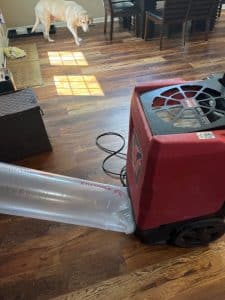At 1st Call Disaster Services, we understand that water damage doesn’t always announce itself with a dramatic flood or burst pipe. Sometimes, the most serious issues start small—just a stain on the ceiling, a musty smell in the basement, or a soft spot in the floor. Recognizing the early signs of water damage can save you from major headaches (and major costs) down the road. Whether you’re a homeowner or business owner, being able to identify these red flags quickly is key to protecting your property.
In this guide, we’ll walk you through the most common signs of water damage, what they mean, and what to do if you spot them. If something on this list sounds familiar, it might be time to make your first call to our expert team.
Key Takeaways
- Look for visible signs like stains, discoloration, warped surfaces, or bubbling paint.
- Pay attention to musty or mildew smells, especially in basements or attics.
- Soft or spongy flooring can indicate hidden moisture underneath.
Increased humidity or condensation may be a clue water is somewhere it shouldn’t be. - High utility bills can signal a hidden leak.
- Mold growth often follows water damage and can harm indoor air quality.
- If you notice any of these red flags, act fast. Delaying repairs can lead to much bigger problems.
Discoloration and Stains
One of the first and most obvious signs of water damage is staining or discoloration on walls, ceilings, and floors. These marks often appear as yellow, brown, or copper-colored patches and may grow larger over time if the source of the water isn’t addressed. In ceilings, this is often the result of a leaky roof or a busted pipe in the floor above. On walls or near baseboards, it could be a plumbing issue inside the wall.
These stains don’t just look bad, they usually mean moisture is actively present or has been in the past. And where there’s moisture, there’s potential for mold growth, warping, and rot.
Bubbling or Peeling Paint and Wallpaper
Is your paint suddenly bubbling, cracking, or peeling for no clear reason? That’s a big red flag for water damage. When water seeps behind your walls, it disrupts the bond between the surface and the paint or wallpaper. In some cases, you’ll even see paint forming soft “bubbles” that you can press in with your finger.
It may be tempting to just scrape and repaint, but doing so without addressing the underlying issue is just putting a Band-Aid on a bigger problem. If you’re noticing this in your home or office, it’s time to investigate further, or let our professionals at 1st Call Disaster Services handle it for you.
Musty Odors
Sometimes, the nose knows before your eyes do. A persistent musty or earthy smell is a common and often overlooked sign of water damage. This odor is usually caused by mold or mildew, which thrive in damp, dark environments.
These smells often pop up in basements, crawl spaces, bathrooms, or anywhere moisture has collected without proper ventilation. Even if you can’t see mold, a lingering odor means it’s probably growing somewhere hidden, like behind walls, under flooring, or inside vents.
At 1st Call Disaster Services, we use advanced moisture detection tools to find the source, even when you can’t.
Warped or Buckling Floors
Wood and laminate floors are particularly sensitive to moisture. If you start to notice warping, buckling, or cupping (where the edges of floorboards curl upward) that’s a strong indicator that water has gotten underneath the materials.
In some cases, tile flooring may begin to loosen or crack, while vinyl may start lifting at the edges. Carpeting may feel damp or develop waves and wrinkles. Any of these flooring issues could be caused by water that’s seeped in due to plumbing leaks, appliance overflows, or foundation issues.
The longer it goes unchecked, the more damage it can cause, not just to the flooring, but to the subfloor and structure beneath it.
Soft or Sagging Drywall
Walls and ceilings made of drywall should be firm and solid to the touch. If they start to feel soft, spongy, or appear to be sagging, that’s another clear sign of water damage. You might even notice your ceiling developing a bubble or bulge, which is generally an indication of water pooling above.
This can happen after a slow leak from an upstairs bathroom, a leaky roof, or even an HVAC system draining improperly. In more serious cases, saturated drywall can collapse, so it’s not something you want to wait on.
At 1st Call Disaster Services, we’ve seen it all, and we’re here to step in before things get worse.
Mold Growth
Mold is one of the most common consequences of untreated water damage. It can begin growing in as little as 24 to 48 hours in the right conditions. Visible mold may appear black, green, white, or even orange, and often shows up in corners, on walls, behind furniture, and in damp places like under sinks.
Mold doesn’t just grow on surfaces. It can also spread behind walls, under flooring, and through ductwork. Mold can also be harmful to your health, especially for those with allergies or respiratory conditions, in addition to causing a variety of structural issues.
If you see mold, or even just suspect it, don’t wait. Give our team a call. We can assess the extent of the water damage and safely handle any necessary cleanup or mold remediation that you may need.
High Humidity and Condensation
Excess moisture in the air can be a symptom of hidden water damage. If you’re noticing a sudden rise in indoor humidity, or frequent condensation on windows, pipes, or walls, there could be a moisture issue nearby.
This often happens in bathrooms, kitchens, or laundry rooms with poor ventilation. But it can also occur when water has soaked into building materials and is now evaporating into the air.
A dehumidifier might help temporarily, but the root cause needs to be addressed. Our team uses professional-grade tools to measure humidity levels and pinpoint hidden water sources.
Unexplained Spikes in Water Bills
Sometimes, water damage starts with a silent leak in areas like behind the wall, under the slab, or in an attic space. These kinds of leaks may not show visible symptoms for a while, but they often show up in your utility bill first.
If your water bill suddenly jumps without a clear explanation, it could be a hidden plumbing issue. Over time, these kinds of leaks can cause serious structural damage and lead to mold infestations.
We always recommend keeping an eye on your water usage, and calling in professionals if something seems off. With leak detection services and thermal imaging, we can help uncover the hidden cause and stop it before the damage spreads.
Cracks in the Foundation or Walls
Water can do serious damage to a building’s foundation over time. If you’re noticing new or widening cracks in your walls or foundation, it might be more than just settling, especially around windows, doors, or in the basement.
Hydrostatic pressure (when water builds up in the soil outside your home) can force its way in through tiny cracks. Over time, this can weaken the foundation and even compromise the integrity of your structure.
Our technicians can assess whether your cracks are cosmetic or something more serious. If water is the culprit, we can help implement solutions to stop the flow and reinforce your foundation.
Rust or Corrosion Around Plumbing Fixtures
Have you noticed rust forming around pipe joints, appliance connections, or valves? Rust is a clear indicator that water has been sitting in a place it shouldn’t be. This often happens with older pipes or plumbing systems with slow leaks.
Left untreated, corrosion can lead to pipe failure and even more water damage. It’s important to inspect these areas regularly, especially under sinks, around water heaters, or near outdoor spigots.
If you spot rust, it’s best to let professionals inspect the system and determine the best course of action. At 1st Call Disaster Services, we work closely with plumbers and property owners to identify the cause and prevent future damage.
What to Do if You Spot These Signs
If any of these signs of water damage sound familiar, don’t ignore them. The longer water damage is allowed to fester, the more costly and dangerous it becomes. Even small issues can evolve into structural damage, toxic mold growth, and major insurance claims.
The good news? You don’t have to deal with it alone.
Why Choose 1st Call Disaster Services?
We’re not just here for emergencies. We’re here to provide you with peace of mind. Our team has years of experience identifying, repairing, and preventing water damage in homes and businesses across our service area. We use industry-leading equipment to detect moisture, dry out affected areas, and restore your space to its pre-loss condition. And we do it all with care, professionalism, and a clear plan.
From the initial assessment to the finishing touches, 1st Call Disaster Services is with you every step of the way.
Call Us Before the Damage Gets Worse
Don’t wait for that stain to grow or that musty smell to turn into a full-blown mold problem. The earlier you catch water damage, the easier (and more affordable) it is to fix. At 1st Call Disaster Services, we’re ready to respond quickly, assess the situation thoroughly, and get your property back to normal.
Whether it’s a sudden leak or signs that have been creeping up slowly over time, we’re your first call for trusted water damage restoration. Reach out today, and let us help you protect your home or business.




